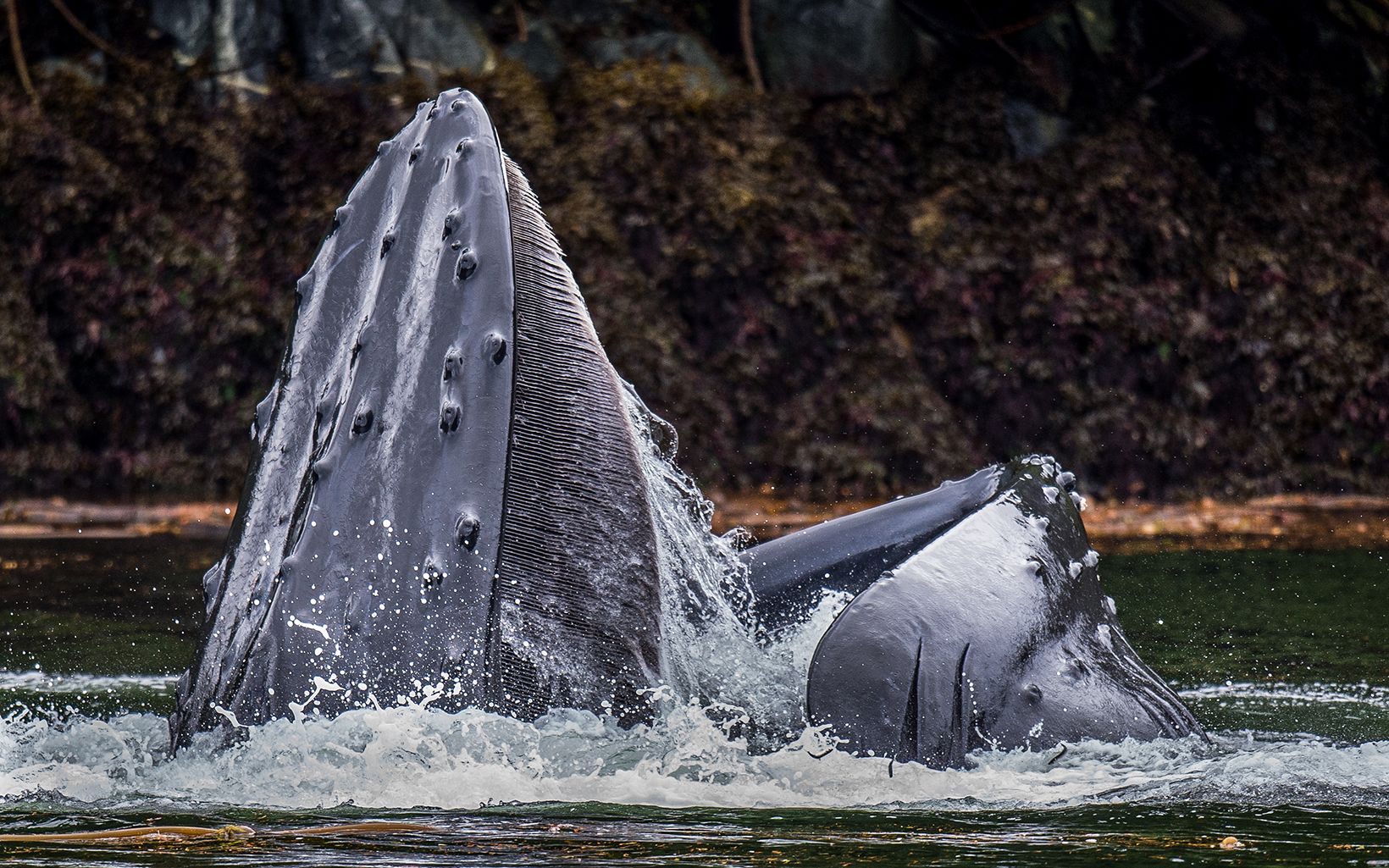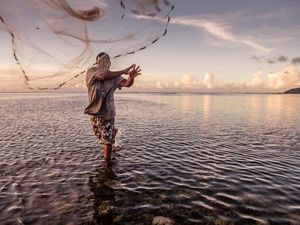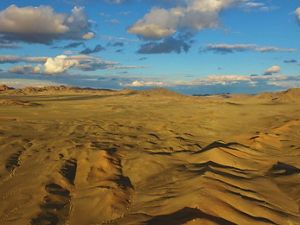Nature’s First Defenders
Indigenous peoples have stewarded lands and waters since time immemorial
Quote: Jess Úst̓i
Everything is connected here, and people are no bigger part of that equation than anything else."
Looking across a lush expanse of deep-green forest, mountains standing tall above the mist and glacier-cut fjords just beyond, Heiltsuk community leader Jess Úst̓i says, “Everything is connected here, and people are no bigger part of that equation than anything else.”
The Heiltsuk lands lie at the heart of the Great Bear Rainforest in British Columbia—the world’s largest intact temperate rainforest and home to some of the greatest biodiversity on the planet—including the iconic “spirit bear” (Kemode bear), a rare subspecies of black bear that has white fur and is found nowhere else on Earth. The Heiltsuk people have a place-based culture, and the Great Bear Rainforest is their place—a connection that archaeologists have determined goes back at least 11,500 years.
“We have a responsibility to uphold our ancestral teachings,” Úst̓i says. “If we can ensure that the next generation knows the things we’re privileged to know, then our Heiltsuk territory will still be here for hundreds of generations to come.”
Earlier this year, the Heiltsuk people and 26 other First Nations reached an agreement to secure the long-term sustainable management and protection of 19 million acres of these ancient ecosystems. The agreement was more than a decade in the making for these First Nations, involving the provincial government, the forestry industry and conservation groups including The Nature Conservancy, which helped broker the deal.
“This is a really big deal,” said Jenny Brown, the Director of Conservation for The Nature Conservancy's Canadian affiliate Nature United. “It lights the path for fulfilling a commitment to a future with some logging, sustainability of old growth forests, and a vital and robust Indigenous voice in this region.”
The story is one that The Nature Conservancy believes has implications for many landscapes and peoples around the world. Over the last decade, the Conservancy’s partnerships with Indigenous peoples and local communities have spanned 27 countries and led to the improved management or conservation of more than 235 million acres of land.
Over that time, experts have found that recognition of community forest rights is strongly associated with low deforestation rates, significant forest cover and the sustainable production of—and lower carbon emissions from—timber and other forest products. With their territories harboring more than 24 percent of the world’s forest carbon and the much of of global terrestrial biodiversity, Indigenous peoples and local communities are key leaders in advancing the world’s aspirations for global sustainable development, nature-based climate mitigation and natural resource management.
Secure home, secure environment
For millennia, Indigenous peoples have both shaped and been shaped by the landscapes in which they’ve lived—protecting and conserving natural resources for future generations, while also managing them for their needs in the present. However, over the last couple centuries, these lands and their peoples have been facing never-before-seen threats from human development.
Without Indigenous peoples consistently at the decision-making table, this development has all too often led to poor outcomes for these cultures and the places they call home—places we all depend on. While many Indigenous peoples and local communities have, over time, reclaimed some of their territory from development and governmental interests, their rights are frequently not fully recognized by governments and their voices not always heard in land management decisions.
For the sustainability movement, these instances are a significant missed opportunity for better development outcomes. It has been widely documented that conservation and development initiatives are more likely to be successful if they have the active engagement and leadership of those with the greatest stake in their outcome. Decades of empirical research show that when a person, group or community fully owns a piece of land, they take actions to better manage it for the long-term. This general finding holds even truer when the community’s cultural values and traditions are rooted in a healthy environment, such as the case with many Indigenous peoples, such as the Heiltsuk, whose identity as a people is indistinct from the land and whose traditional knowledge weaves together the two.

Indigenous and Local Community Lands by the Numbers
While the claims of customary land users cover more than 50 percent of the world’s land area, Indigenous peoples and local communities hold formal rights to only 18 percent of global lands.
Their territory harbors well over 24 percent of forest carbon stores and much of the Earth’s biodiversity.
This means that up to 2.5 billion men and women have legal rights to just one-fifth of the land that is rightfully theirs.
Strong voices, active choices
Over the last decade, partnerships between Indigenous peoples and local communities and The Nature Conservancy have demonstrably improved the well-being of nearly one million people through wealth creation, enhanced security and greater empowerment. These inspiring results, including the recent milestone agreement for the First Nations in Great Bear, have informed the evolution of the Conservancy’s community conservation strategy and the creation of more ambitious outcomes for conservation and sustainable development.
The Conservancy’s evolved Global Strategy for Conservation in Partnership with Indigenous Peoples and Local Communities includes a focus on: securing access to resources; strengthening leadership; supporting effective multi-stakeholder platforms; and creating opportunities for wealth creation.
Erin Myers Madeira, Lead of the Indigenous Peoples and Local Communities program at the Conservancy, says the strategy recognizes that a stronger voice for Indigenous peoples and local communities leads to greater inclusion of traditional knowledge, local priorities and local values in development plans and solutions. And the ability to exercise and influence choice builds leadership and engagement to drive better outcomes. It’s a virtuous cycle that better positions these communities to initiate and participate in the implementation of programs and the management of resources that impact their well-being both now and in the future.
Download
-
 Strong Voices, Active Choices
Strong Voices, Active ChoicesThe Nature Conservancy's practitioner framework to strengthen outcomes for people and nature.
DOWNLOAD
“This is one of the most important conservation—and climate—strategies available to the world,” says Madeira. “Our work on the ground demonstrates time and again that strengthening the communities’ leadership in environmental and development decisions contributes to sustainable outcomes for local communities, the economy and the environment. Results at the local and regional level have provided solid outcomes to hundreds of communities.”
Quote: - Erin Myers Madeira
This is one of the most important conservation—and climate—strategies available to the world."




Guardians against climate change
Governments, investors, the development community, climate negotiators, agribusiness and miners, among others, have started to see this connection between strong Indigenous and community leadership and sustainable economic development, as well as climate change mitigation.
However, only 21 of the 193 signing countries of the recently-ratified Paris Climate Agreement currently include clear commitments to implement community-based natural resource management strategies as part of their plans to mitigate climate change. These 21 Intended Nationally Determined Contributions (INDCs) represent just 13 percent of the world’s tropical and subtropical forests.
“A sustainable future for all of us requires a complete re-thinking of what collaboration looks like,” says Madeira. One part of the equation, as Madeira points out, is that Indigenous peoples’ visions for their territories lead the creation of sustainable development pathways that align with their cultures and goals for conservation. The other part of the equation is that there must be effective forums for Indigenous peoples to work in equal partnership with governments, companies and other organizations to shape future development, climate action and natural resource management.
Facilitating these complex steps is where groups like the Conservancy can play an important role. “We know that when Indigenous peoples and local communities are part of decision-making forums characterized by diversity, trust and true co-leadership, more creative and lasting solutions to some of today’s most pressing environmental and development challenges emerge,” says Madeira. “We must trust in nature’s best guardians to help create our collective future.”
Úst̓i echoes that sentiment. “For us as Heiltsuk people, we know that we are the best people to take care of this place. We know because we’ve been doing it for tens of thousands of years,” she explains. “It’s an empowering thing—knowing that in everything you do, the ancestors have their hands on your shoulders. It’s beautiful to know that you’re part of such a long, sacred continuum.”
The Great Bear Rainforest
The Great Bear Rainforest stretches across the coast of British Columbia from the north end of Vancouver Island to the border with Alaska. In this deeply interconnected ecosystem, thousand-year-old trees stand sentinel over the mossy hush. Its forests, streams, and marine waters are home to wolves, whales, salmon and other wildlife, including the iconic spirit bear, or kermode, a rare white form of black bear. The Great Bear Rainforest is also homeland to First Nations, whose very being is intertwined with the region’s natural abundance.
In February 2016, an agreement was signed between the government of British Columbia and the governments of 26 First Nations that will forever conserve 19 million acres of this critical landscape. The agreement bans logging on much of the land and setting stringent ecological protections on the remaining portions.
Over the last decade, The Nature Conservancy’s focus has been on strengthening the leadership of First Nations communities and the authority of their governments over resource-management decisions. To support an initial Great Bear Rainforest Agreement, the Conservancy raised $39 million, leveraging another $81 million in additional private and public funding to be made available to First Nations communities. These funds have been aimed at advancing economic development and capacity for resource management in the region, including to-date the creation of more than 40 new First Nation businesses and 500 new permanent, local jobs.
Resources
-

October 2016
The Nature Conservancy's practitioner framework to strengthen outcomes for people and nature.
DOWNLOAD
Global Insights
Check out our latest thinking and real-world solutions to some of the most complex challenges facing people and the planet today.


